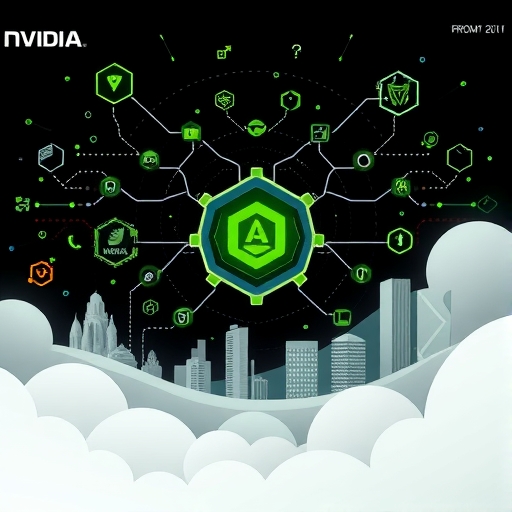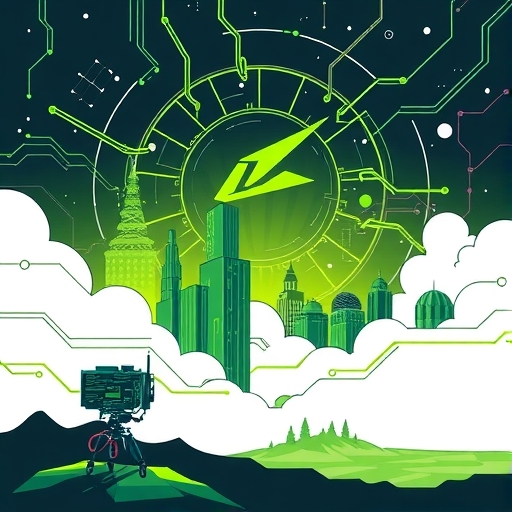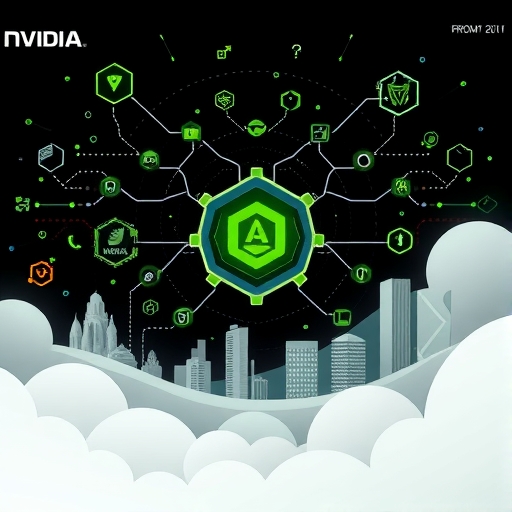The AI Revolution’s Unstoppable Force: Nvidia’s Competitive Advantage
Welcome to the dynamic world of investing, where understanding the fundamental strengths of a company can be just as crucial as technical analysis. Today, we’re going to delve deep into a company that has not only captured global headlines but has fundamentally reshaped our technological landscape: Nvidia (NVDA). Its ascent has been nothing short of spectacular, driven by its central role in the artificial intelligence (AI) revolution. But what exactly underpins this incredible rise? Is it just hype, or is there a durable, expanding competitive advantage – a ‘moat’ – that solidifies its leadership?
- Nvidia is at the forefront of AI technology, significantly impacting various sectors.
- The company has expanded its offerings beyond gaming to include data center operations.
- Understanding Nvidia’s competitive advantage is crucial for investment decisions.
We’re not just looking at a stock chart; we’re dissecting the core business, the technology, the market dynamics, and the strategic decisions that place Nvidia at the forefront of one of the most transformative technological shifts in history. Whether you’re just starting your investment journey or you’re a seasoned trader looking to understand the forces driving market leaders, comprehending Nvidia’s unique position is essential in today’s market.
We will explore how Nvidia built its dominant position, why its lead appears to be widening, and what factors contribute to its powerful market share and profitability. Get ready to gain a deeper understanding of the engine powering the AI era, and how this engine translates into a formidable competitive edge.
Nvidia’s Ascent to Global Leadership: Beyond Market Cap Milestones
You’ve likely seen the headlines: Nvidia recently became the world’s most valuable publicly traded company by market capitalization, momentarily surpassing giants like Microsoft. This wasn’t just a symbolic achievement; it was a powerful indicator of how profoundly the market values Nvidia’s current position and future potential in the AI space. Reaching a valuation nearing $3.77 trillion is not a result of gradual growth; it’s the consequence of exponential demand fueled by a technological paradigm shift.
Think of it this way: just a few years ago, Nvidia was primarily known for its graphics cards that powered video games. While that remains a significant part of its business, the true surge has come from its data center division, specifically the demand for its Graphics Processing Units (GPUs) in AI applications. This pivot, planned and executed over a decade ago by CEO Jensen Huang, has perfectly positioned Nvidia to capitalize on the sudden explosion of AI, particularly the development of large language models (LLMs) and generative AI.
Strong quarterly earnings reports consistently demonstrate the voracious appetite for Nvidia’s chips. These reports don’t just show revenue growth; they highlight the scale of investment being made by the world’s largest technology companies in building their AI capabilities. This isn’t discretionary spending; it’s an “AI arms race,” as many analysts describe it, and Nvidia is supplying the essential weaponry.
This rapid ascent to the top of the market cap leaderboard underscores the sheer magnitude of the AI megatrend and Nvidia’s indispensable role within it. It reflects high customer demand, operational excellence in scaling production (despite challenges), and a perceived lack of immediate, scalable alternatives for the most cutting-edge AI work. It’s a position built on more than just market sentiment; it’s rooted in fundamental technological leadership and strategic positioning.

Here is a visualization of Nvidia’s role in the AI revolution.
Fueling the Engine: The Hyperscaler Demand for AI Infrastructure
Who are the primary customers driving this unprecedented demand for Nvidia’s data center products? The answer is clear: the major hyperscale cloud providers and large tech companies. Think of names like Microsoft, Meta Platforms, Alphabet (Google), and Amazon (AWS). These companies are building the foundational AI infrastructure for the future, and they are doing it overwhelmingly on Nvidia’s architecture.
Why are these tech giants investing so heavily? Because AI is no longer a niche technology; it’s becoming integrated into nearly every product and service they offer. From powering search algorithms and social media feeds to developing autonomous vehicles and advanced robotics, AI requires immense computational power. Training the massive LLMs that underpin services like generative AI chatbots or complex data analysis tools demands clusters of thousands, even tens of thousands, of high-performance GPUs working in parallel.
These hyperscalers aren’t just buying a few chips; they are deploying entire data centers or sections of data centers dedicated solely to AI workloads, built around Nvidia’s hardware and software stack. This creates a level of demand that is both massive and relatively stable, as these infrastructure build-outs are long-term strategic investments, not short-term discretionary purchases.
This reliance on Nvidia by the biggest players in the tech industry is a significant component of its competitive advantage. It validates the performance and scalability of Nvidia’s solutions and creates a feedback loop: as these companies build on Nvidia, developers build on Nvidia, further solidifying its ecosystem. This heavy customer spending isn’t just boosting Nvidia’s revenue today; it’s laying the groundwork for its continued dominance tomorrow.
The Dual Core of Dominance: GPUs and the Indispensable CUDA Ecosystem
At the heart of Nvidia’s competitive moat lies the powerful combination of its industry-leading hardware – the GPUs – and its foundational software platform, CUDA. While many companies can produce powerful semiconductor chips, Nvidia’s edge comes from the synergy between its silicon and the software environment designed specifically for it.
Let’s start with the hardware. Nvidia’s GPUs, like the Hopper H100 or the newer Blackwell B200, are specifically designed for parallel processing, making them exceptionally well-suited for the complex matrix multiplications and linear algebra operations required for training and running AI models. While competitors like AMD have developed their own AI accelerators, Nvidia has consistently maintained a performance lead and, crucially, a head start of several years in optimizing its architecture for these specific workloads.
But hardware alone isn’t enough. The true differentiator is CUDA. Launched in 2006, CUDA is Nvidia’s proprietary parallel computing platform and programming model. Think of CUDA as the “operating system” or the “language” specifically designed to unlock the full potential of Nvidia’s GPUs for general-purpose computing, including AI. It provides developers with the tools, libraries, and APIs they need to easily program Nvidia GPUs.
Why is CUDA so critical? Because AI research and development have overwhelmingly standardized on CUDA. Academic institutions, startups, and major tech companies have spent years, collectively, building models, frameworks (like TensorFlow and PyTorch, which heavily integrate with CUDA), and applications using the CUDA platform. This means that switching to a different hardware platform that doesn’t support CUDA is not a simple plug-and-play operation; it often requires significant code rewriting, re-optimization, and retraining of personnel.
This decades-long investment in CUDA has created an incredibly sticky ecosystem. Developers are familiar with it, have built extensive toolsets around it, and rely on its mature libraries for performance and ease of use. This deep integration of hardware and software creates a formidable barrier to entry for competitors, giving Nvidia a powerful dual-engine advantage that is much harder to replicate than just designing a fast chip.

This image illustrates the role of GPUs in powering AI technologies.
Building the Moat Wider: Developer Lock-in and Network Effects
Expanding on the power of CUDA, we can clearly see the effects of “developer lock-in” and a potent network effect at play. Nvidia’s CUDA platform isn’t just a software layer; it’s the bedrock of the AI development community. Consider the millions of developers, researchers, and engineers worldwide who have been trained on and actively use CUDA. They have written billions of lines of code, built complex models, and rely on the vast ecosystem of libraries, frameworks, and tools that are CUDA-compatible.
For a company or research institution heavily invested in AI, migrating away from the CUDA ecosystem is an enormous undertaking. It’s not merely a technical challenge of getting new hardware to run; it involves rewriting proprietary codebases, adapting workflows, retraining staff, and potentially sacrificing performance or access to optimized libraries. The cost and complexity of this transition create significant “switching costs” for customers, effectively locking them into the Nvidia platform, at least for their most critical and advanced AI workloads.
Furthermore, this widespread adoption of CUDA creates a powerful network effect. As more developers use CUDA, more tools and libraries are developed for it, making the platform even more attractive and capable. This, in turn, attracts more users and developers, creating a virtuous cycle that continuously strengthens Nvidia’s position. New hardware innovations from Nvidia seamlessly integrate with the existing CUDA ecosystem, providing an easy upgrade path for customers already invested in the platform, further reinforcing their reliance.
This combination of developer lock-in and a self-reinforcing network effect within the CUDA ecosystem arguably represents the strongest pillar of Nvidia’s competitive advantage. It makes them incredibly difficult to dislodge, even if a competitor manages to develop a chip with comparable raw performance. The software moat, built over nearly two decades, is just as significant, if not more so, than the hardware lead.
Mastering the Full Stack: From Chips to Cloud Services
Nvidia’s strategy extends beyond just selling high-performance GPUs and providing the CUDA software. The company has aggressively built out an “end-to-end stack” for AI. This means they offer hardware, system-level solutions (like DGX systems), a comprehensive software platform including specialized libraries (like TensorRT for inference optimization or NeMo for building generative AI), and even cloud services (DGX Cloud). This integrated approach is a critical part of their competitive advantage.
Why is offering a full stack so powerful? For large customers, particularly the hyperscalers, integrating hardware and software from multiple vendors can be complex, time-consuming, and prone to compatibility issues. Nvidia offering a complete, optimized solution simplifies deployment, accelerates time-to-value, and ensures that customers can extract maximum performance from their hardware.
Imagine building a complex AI supercomputer. Instead of sourcing chips from one vendor, networking from another, and relying on open-source software that may or may not be perfectly optimized, a customer can turn to Nvidia for a cohesive solution where all components are designed to work together seamlessly. This level of integration reduces operational headaches and allows companies to focus on building their AI models and applications, rather than troubleshooting infrastructure.
By providing this end-to-end solution, Nvidia captures more value across the AI value chain. They are not just a component provider; they are an infrastructure partner. This positions them as indispensable to companies looking to build and deploy AI at scale, further solidifying their competitive edge and making it harder for rivals who may only offer parts of the solution to gain traction. It’s about selling the entire high-performance kitchen, not just a single, albeit powerful, appliance.
Navigating the Competitive Landscape: Why Nvidia Stays Ahead of AMD
While Nvidia enjoys a dominant position, the AI accelerator market is not without competition. Advanced Micro Devices (AMD) is often cited as the primary rival, particularly with its Instinct line of accelerators designed for AI workloads. However, market share data reveals a stark reality: Nvidia holds an overwhelming lead.
According to reports, Nvidia commanded approximately 88% of the AI accelerator market share in the first quarter of 2024, while AMD held around 4%. This significant disparity highlights the strength of Nvidia’s moat, despite AMD’s efforts to gain ground. AMD has introduced new chipsets like the MI300X, which are technically competitive in certain benchmarks.
Yet, customers continue to prioritize Nvidia’s newer offerings, such as the Blackwell B200, even when AMD’s products become available. Why is this the case? Several factors contribute. First, as discussed, the CUDA ecosystem advantage is paramount. Customers deeply invested in CUDA are hesitant to switch. Second, Nvidia often maintains a performance-per-dollar or performance-per-watt advantage in real-world AI training scenarios, despite competitive claims. Third, Nvidia has a proven track record of delivering at scale and providing robust support for complex deployments.
While AMD’s chips may be viable alternatives for certain less complex workloads or for companies explicitly seeking vendor diversity, Nvidia remains the default choice for leading-edge AI training and deployment, particularly for the large hyperscalers. This doesn’t mean AMD won’t gain some share over time, but overcoming Nvidia’s established hardware lead, software moat, and ecosystem dominance is a monumental challenge that has yet to materialize into a significant shift in market share.
Strategic Moves: How Acquisitions Bolster the Competitive Edge
A company’s competitive advantage isn’t static; it must be actively defended and strengthened. Nvidia understands this and has made strategic moves to enhance its capabilities and expand its moat. A recent example highlighted in financial discussions is the acquisition of AI startup CentML.
CentML specializes in optimizing AI model performance across different hardware platforms. While this might sound counterintuitive for a hardware vendor, for Nvidia, it’s about making *their* platform the most efficient and attractive option available. By integrating CentML’s expertise and technology, Nvidia can further enhance the performance of AI models running on its GPUs, regardless of where those models were originally developed or what framework they use. This acquisition strengthens Nvidia’s software stack and optimization tools.
Why is this a competitive advantage? It makes Nvidia’s solution even more performant and cost-effective for customers running complex AI workloads. Better optimization means faster training times, more efficient inference, and ultimately, lower operational costs for customers. By acquiring companies like CentML, Nvidia is not just relying on its existing lead; it is proactively investing in technologies that will ensure its hardware remains the most performant and easiest to optimize for the most demanding AI tasks.
Such strategic acquisitions are not just about adding new features; they are about integrating key technologies that reinforce the core competitive advantages – enhancing the software ecosystem, improving hardware utilization, and making the overall Nvidia platform stickier and more valuable to customers. It’s a sign of a company actively working to widen its lead in a fast-evolving market.
Wall Street’s Verdict: Analyst Sentiment and the Expanding Moat
What does the financial community, particularly Wall Street analysts, think about Nvidia’s competitive position and future prospects? The sentiment is overwhelmingly bullish. According to data aggregated from various sources, a significant majority – often around 90% – of analysts covering Nvidia rate the stock a “buy.”
Analysts aren’t just impressed by past performance; they are projecting continued strength. Many explicitly cite Nvidia’s expanding competitive moat as the primary reason for their confidence. Figures like Michael Smith at Loop Capital have stated that the AI “arms race” could last for several years, with Nvidia remaining the key supplier. Analysts at firms like Bank of America have reiterated strong buy ratings, pointing to the company’s deep customer relationships and technological lead.
Their price targets for NVDA stock are also notably high, often suggesting significant upside potential even after the massive gains the stock has already seen. For example, some targets have been set as high as $250 (adjusted for splits). This indicates a belief that the current demand for AI infrastructure is not a short-term spike but a sustained, multi-year investment cycle.
The consensus among analysts is that Nvidia’s combination of hardware performance, the indispensable CUDA software ecosystem, and strategic positioning creates a competitive barrier that is difficult for rivals to overcome in the near to medium term. While acknowledging potential risks like supply chain constraints or fluctuations in customer spending, the overall outlook is one of continued market dominance and strong financial performance driven by the relentless global pursuit of AI capabilities. Wall Street’s confidence is a reflection of the perceived durability and growth potential of Nvidia’s competitive advantage.
Examining the Valuation: Growth vs. Price
Given the astronomical rise in Nvidia’s stock price, you might understandably wonder: is it overvalued? Valuing high-growth technology companies is complex, and traditional metrics like the simple Price-to-Earnings (P/E) ratio can look extraordinarily high, potentially signaling overvaluation. However, investors often look at metrics that factor in growth, such as the PEG ratio (P/E divided by the expected earnings growth rate).
Interestingly, despite its massive market cap and stock appreciation, Nvidia’s PEG ratio has sometimes been cited as being lower than some of its “Magnificent Seven” peers. This suggests that, *relative to its expected future earnings growth*, the stock might not be as expensive as the P/E ratio alone would imply. Analysts setting high price targets are factoring in very aggressive growth forecasts for Nvidia’s earnings over the coming years, driven by the insatiable demand for AI infrastructure.
Think of it as paying a premium, but potentially a justified premium, for a company with exceptional growth prospects and a strong competitive moat in a rapidly expanding market. The valuation reflects the market’s confidence in Nvidia’s ability to execute, maintain its technological lead, and continue to capture the lion’s share of spending in the AI space for the foreseeable future.
However, valuation is always subjective and dependent on future execution and market conditions. While metrics like the PEG ratio offer a way to contextualize the price relative to growth, any slowdown in the pace of AI investment or increased competition could impact these projections and the stock’s valuation. For now, the market appears willing to pay a premium for what it perceives as Nvidia’s critical technology and dominant position.
Understanding the Risks: Dependencies and Future Outlook
While Nvidia’s competitive advantage appears robust, it’s crucial for any investor or trader to understand the potential risks and dependencies that could impact its trajectory. No company operates in a vacuum, and even dominant players face challenges.
One significant dependency is the pace of AI investment by its major customers, the hyperscalers. While their current build-out is aggressive and long-term, any future slowdown in their capital expenditures could directly impact Nvidia’s revenue growth. Macroeconomic conditions or shifts in these companies’ strategic priorities could influence spending levels.
Regulatory environments also pose potential risks. Restrictions on selling high-performance AI chips to certain regions, such as ongoing regulations impacting sales to China, can limit market access and require product modifications, impacting revenue and development costs.
Furthermore, while the competitive moat is strong, it’s not impenetrable forever. Should a competitor develop a truly disruptive technology, a compelling software alternative that gains widespread adoption, or if the AI landscape fundamentally shifts in a way that de-emphasizes current GPU architectures, Nvidia’s position could be challenged. While less likely in the near term, long-term technological shifts are always a factor in the tech industry.
Finally, execution risk exists. Can Nvidia continue to innovate at the required pace? Can it manage its supply chain effectively to meet demand? Can it navigate geopolitical complexities? These operational and strategic challenges, while often well-managed by Nvidia, are inherent risks that could affect its ability to capitalize on its competitive advantage and maintain its growth trajectory.
Understanding these risks provides a more balanced perspective, essential for making informed investment decisions, even when analyzing a company with such clear strengths.
Conclusion: Nvidia’s Enduring Influence in the Age of AI
Nvidia’s journey from a graphics card manufacturer to the world’s most valuable company is a powerful case study in identifying and capitalizing on a major technological shift. Its remarkable rise is fundamentally underpinned by a multifaceted and, importantly, *expanding* competitive advantage in the artificial intelligence market.
| Factor | Description |
|---|---|
| Industry-Leading Hardware | Nvidia’s powerful GPUs drive AI performance. |
| Indispensable Software Ecosystem | CUDA provides a robust platform for AI development. |
| End-to-End Solutions | Complete offerings attract major customers. |
This moat isn’t built on a single factor but on the synergistic combination of industry-leading hardware (GPUs), a deeply entrenched and indispensable software ecosystem (CUDA), a comprehensive end-to-end stack that simplifies deployment for major customers, overwhelming market share dominance, and strategic investments that reinforce its leadership. The developer lock-in created by CUDA and the high switching costs it imposes on customers are particularly potent barriers to entry for competitors.
While challenges exist, including dependency on customer spending cycles and regulatory hurdles, the current landscape suggests Nvidia is uniquely positioned to remain the primary beneficiary of the ongoing global investment in AI infrastructure. The consensus among financial analysts reflects confidence in the durability of this competitive moat and the potential for continued growth.
For you, as an investor or trader, understanding the depth and breadth of Nvidia’s competitive advantage provides crucial context behind the headlines and stock movements. It highlights why Nvidia is more than just a chip company; it is the foundational provider for the AI future being built today. As the AI revolution continues to unfold, Nvidia’s well-fortified competitive position appears set to ensure its enduring influence on the technological and financial markets.
Learning to identify such deep-seated competitive advantages – whether in technology stocks, consumer goods, or other sectors – is a valuable skill in your investment journey. It moves you beyond simply reacting to market noise and helps you understand the underlying forces that drive long-term value creation.

This image represents Nvidia’s competitive advantage in the technology landscape.
nvidia competitive advantageFAQ
Q:What factors contribute to Nvidia’s competitive advantage?
A:Nvidia’s competitive advantage stems from its industry-leading GPUs, the CUDA software ecosystem, and a comprehensive end-to-end AI infrastructure.
Q:How significant is Nvidia’s market share in the AI accelerator market?
A:Nvidia commands approximately 88% of the AI accelerator market share, indicating a strong position against rivals like AMD.
Q:What risks does Nvidia face that could impact its growth?
A:Nvidia faces risks such as dependency on AI investment from customers, regulatory challenges, and competition from emerging technologies.

留言